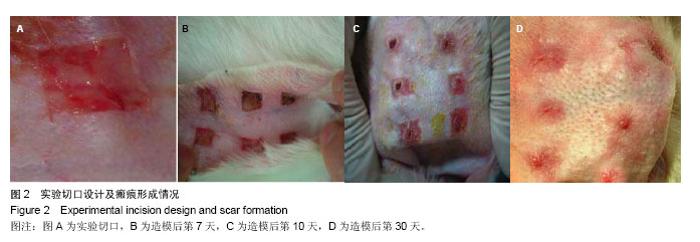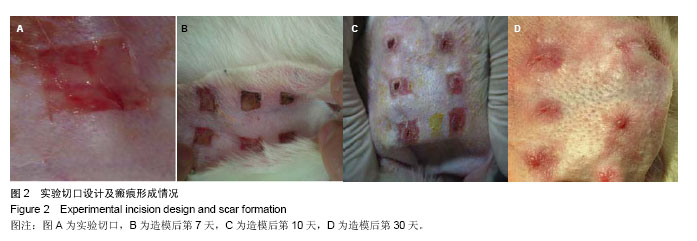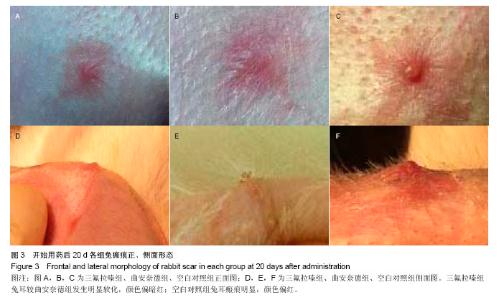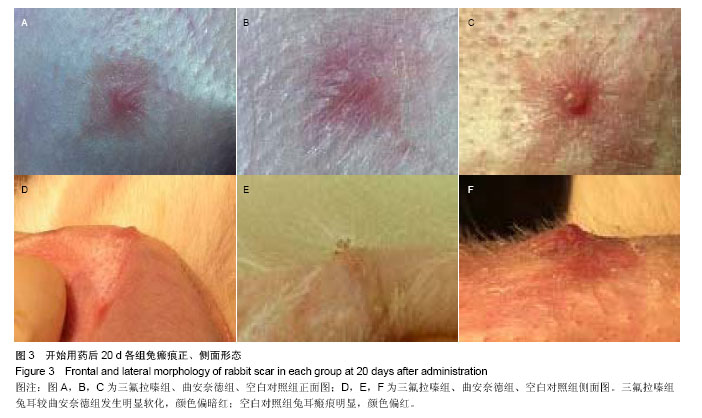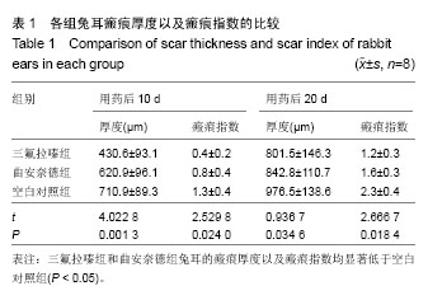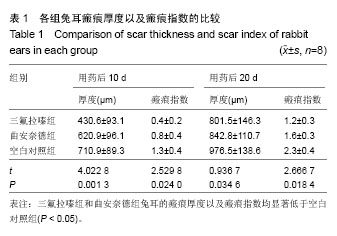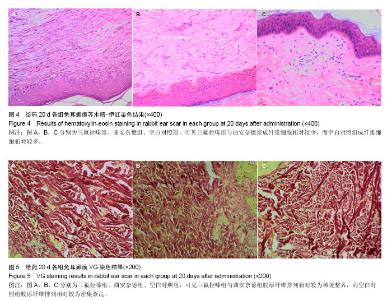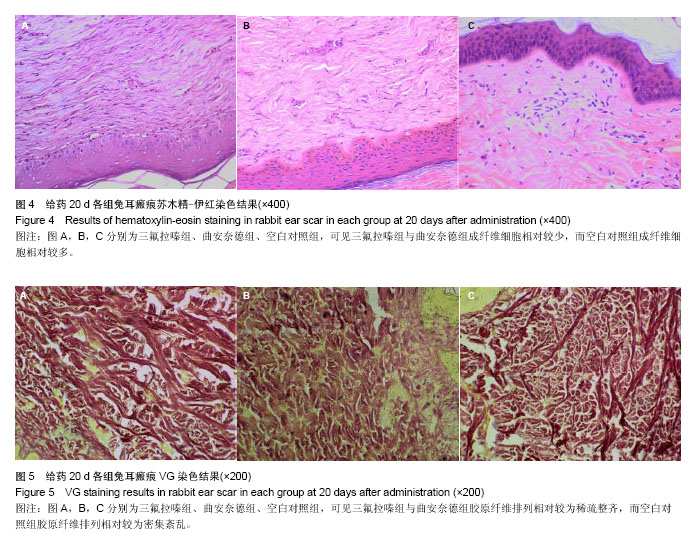| [1] 张建华,欧斌贤,蒙诚跃,等.早期注射丹参酮ⅡA磺酸钠可抑制兔耳增生性瘢痕[J].中国组织工程研究与临床康复,2011,15(50): 9457-9461.
[2] 卞媛媛,梁久龙,韩悦,等.兔自体脂肪来源干细胞对增生性瘢痕的作用研究[J].实用皮肤病学杂志,2013,6(1):3-6.
[3] 樊竹,马尚清,董徐斌,等.电针抑制兔耳增生性瘢痕形成的作用研究[J].中国美容医学,2013,22(18):1860-1863.
[4] 邱竣,柳大烈,张阳,等.细菌纤维素减轻兔耳增生性瘢痕的作用[J].中国组织工程研究与临床康复,2011,15(25):4597-4601.
[5] 张艳,邱林,吴清华,等.黄芪对兔耳增生性瘢痕作用的实验研究[J].重庆医科大学学报,2010,35(6):864-868.
[6] 王西樵,刘英开,宋菲,等.内皮抑素局部注射对兔耳增生性瘢痕的影响[J].上海交通大学学报(医学版),2011,31(12):1672-1675, 1701.
[7] 李石峰.IPL治疗兔耳增生性瘢痕的实验研究[D].南华大学,2013.
[8] 陈鑫,李伟人,孔豫苏,等.曲安奈德抑制兔耳瘢痕增生与氧自由基作用的初步研究[J].中华整形外科杂志,2010,26(6):440-443.
[9] 董向前,段丽,平梁兵,等.人参皂苷Rg1和Rb1抗肝纤维化的研究[J].山东大学学报(医学版),2012,50(1):85-88.
[10] 雷颖,谭军,李高峰.超脉冲点阵CO2激光在浅表性瘢痕治疗中的应用[J].中国美容医学,2011,20(12):2004-2006.
[11] 仇雪枫,孙炳伟. 102例颈部瘢痕挛缩的手术治疗[J].中国医药科学,2011,1(5):59.
[12] 于蓉,岑瑛.TGF-β1/Smad3信号转导通路与创伤后瘢痕形成[J].中国修复重建外科杂志,2012,26(3):331-336.
[13] 刘树发,刘浩. 丹参酮IIA磺酸钠治疗兔耳增生性瘢痕中MMP- 1mRNA表达的影响[J].现代口腔医学杂志,2011,25(4): 294-298.
[14] 王勇,杨永滨,马玉琛. MMP1、MMP2 和 TIMP2 在雄附方干预大鼠肺间质纤维化中的作用[J].解放军医学院学报,2013,34(4): 376-378.
[15] 陈荣权,陈香美,崔世维,等.基质金属蛋白酶/组织金属蛋白酶抑制物表达失衡在衰老大鼠肾小管间质损害中的意义[J].中华医学杂志,2004,84(11):937-942.
[16] Kozhevnikova LM, Avdonin PV.Involvement of calmodulin in realization of vasoconstrictive effects of serotonin and norepinephrin.Izv Akad Nauk Ser Biol. 2012;(4):430-437.
[17] 田勇,乔健,赵立红,等.钙调素拮抗剂三氟拉嗪对犬肾上皮细胞增殖的影响[J].中国农业大学学报,2007,12(3):5-8.
[18] 赵刚,张洪义.细胞骨架协同基质金属蛋白酶促进肿瘤侵袭的研究进展[J].癌症进展,2012,10(2):136-140.
[19] 于秀文,曾林祥. Notch信号通路对肌成纤维细胞转化中α-SMA表达变化的影响[J].中国现代医学杂志,2013,23(13):20-24.
[20] 毛忠懿,吴雄健,胡志燕.贝那普利对肝纤维化大鼠TGF-β1和α-SMA影响的研究[J].中国当代医药,2013,20(36):30-33.
[21] 安静,隋建丽,徐勤枝,等.三氟拉嗪诱发细胞凋亡及对DNA依赖蛋白激酶催化亚单位表达和P38磷酸化的抑制作用[J].中国药理学与毒理学杂志,2005,19(2):98-102.
[22] 王智,姚艳娇,张明昌.三氟拉嗪对体外培养人晶状体上皮细胞增殖作用的实验研究[J].眼视光学杂志,2006,8(3):152-153.
[23] 高彦军,马景学,安建斌,等.丹参单体、三氟拉嗪对视网膜色素上皮细胞增殖抑制的研究[J].眼科新进展,2011,31(9):820-823.
[24] 樊粉霞, 张伟.三氟拉嗪通过诱导p16INK4a抑制BGC-823细胞增殖[J].中国生物化学与分子生物学报, 2011, 27(10): 950-955.
[25] 韩远远,刘益民,王玉. 转化生长因子β1降低大鼠自发性癫痫发作并抑制胶质细胞活化[J]. 中国病理生理杂志,2012,28(12): 2266-2269,2282.
[26] 黄静仪,刘林蟠,张建文. MMP-2、MMP-9及其抑制因子TIMP-2、TIMP-1在非黑色素性皮肤癌中的表达及意义[J].中国美容医学,2011,20(12):1912-1915.
[27] 赵铭锋,朱玉红,刘鲁英,等.干扰素α-1b对HepG2细胞MMP-2和TIMP-2表达水平影响的研究[J].中华肿瘤防治杂志,2012, 19(3):201-204.
[28] 姚泉,马少林.曲安奈德与5-氟尿嘧啶联合应用在瘢痕疙瘩临床疗效的Meta分析[J].中国美容医学,2013,22(12):1294-1299.
[29] 白冰,张玉龙,张米娜.手术切除联合注射曲安奈德加放疗治疗瘢痕疙瘩的疗效观察[J].中国美容医学,2013,22(20):2015-2017.
[30] 黄志群,陆钢,谷世行,等. 三种疗法治疗瘢痕疙瘩的比较研究[J]. 医学与哲学:临床决策论坛版,2013,34(2):33-34.
[31] Bayat A, Bock O, Mrowietz U,et al. Genetic susceptibility to keloid diseaseand hypertrophic scaring:transforming growth factor β 1 commonpolymorphisms and plasma levels. Plast Reconstr Surg. 2003;111:535-543.
[32] Lekic P, McCulloch CA. Periodontal ligament cell populations : the centralrole of fibroblasts in creating a unique tissue. Anat Rec.1996; 245(2):327-341.
[33] Amadeu TP,Coulomb B, Desmouliere A.Cutaneous wound healing: myofibroblasts differentiation and in vitro models. Lower Extrem Wounds. 2003; 2(2): 60-68.
[34] Laxova A, Earley M, Farrell P, et al. Results of DNA-based cystic fibrosis newborn screening proficiency testing.J Cystic Fibrosis. 2008;6(2): S14.
[35] Chen J,Graham SH,Nakayama M,et al.Apoptosis repressor gene bcl-2 and bcl-xl are expressed in the rat brain following global is chemia. J Cereb Blood Flow Metab. 1997;11(1):1-10.
[36] Graham SH,Chen J,Glark RS.Bcl-2 family gene products in cerebral ischema and traumatic brain injury. J Neurotrauma. 2000;17(10):831-841.
[37] Kluck RM,Bossy Wetzel E,Green DR,et al.The release of cytochrome C from mitochondria: a primary site for Bcl-2 regulation of apoptosis. Science. 1997;275(5303): 1132-1136.
[38] Shimizu S,Narita M,Tsujimoto Y.Bcl-2 family proteions regulate the release of apoptogenic cytochrome by the mitochondriam channe VDAC.Nature. 1999;399(6375):483-487.
[39] Shetlar MR, Sherlar CL,Hendricks L, et al.The use of athynmic nude mice for the study of human keloids.Procsoe Exp Biol Med. 1985;179(4):549-552. |
